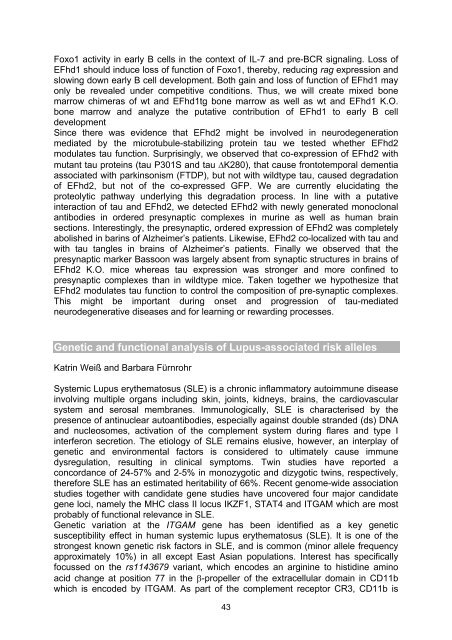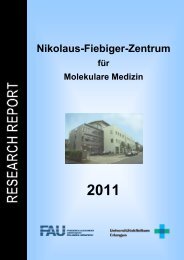Research Report - Nikolaus-Fiebiger-Zentrum für Molekulare Medizin
Research Report - Nikolaus-Fiebiger-Zentrum für Molekulare Medizin
Research Report - Nikolaus-Fiebiger-Zentrum für Molekulare Medizin
You also want an ePaper? Increase the reach of your titles
YUMPU automatically turns print PDFs into web optimized ePapers that Google loves.
Foxo1 activity in early B cells in the context of IL-7 and pre-BCR signaling. Loss of<br />
EFhd1 should induce loss of function of Foxo1, thereby, reducing rag expression and<br />
slowing down early B cell development. Both gain and loss of function of EFhd1 may<br />
only be revealed under competitive conditions. Thus, we will create mixed bone<br />
marrow chimeras of wt and EFhd1tg bone marrow as well as wt and EFhd1 K.O.<br />
bone marrow and analyze the putative contribution of EFhd1 to early B cell<br />
development<br />
Since there was evidence that EFhd2 might be involved in neurodegeneration<br />
mediated by the microtubule-stabilizing protein tau we tested whether EFhd2<br />
modulates tau function. Surprisingly, we observed that co-expression of EFhd2 with<br />
mutant tau proteins (tau P301S and tau �K280), that cause frontotemporal dementia<br />
associated with parkinsonism (FTDP), but not with wildtype tau, caused degradation<br />
of EFhd2, but not of the co-expressed GFP. We are currently elucidating the<br />
proteolytic pathway underlying this degradation process. In line with a putative<br />
interaction of tau and EFhd2, we detected EFhd2 with newly generated monoclonal<br />
antibodies in ordered presynaptic complexes in murine as well as human brain<br />
sections. Interestingly, the presynaptic, ordered expression of EFhd2 was completely<br />
abolished in barins of Alzheimer’s patients. Likewise, EFhd2 co-localized with tau and<br />
with tau tangles in brains of Alzheimer’s patients. Finally we observed that the<br />
presynaptic marker Bassoon was largely absent from synaptic structures in brains of<br />
EFhd2 K.O. mice whereas tau expression was stronger and more confined to<br />
presynaptic complexes than in wildtype mice. Taken together we hypothesize that<br />
EFhd2 modulates tau function to control the composition of pre-synaptic complexes.<br />
This might be important during onset and progression of tau-mediated<br />
neurodegenerative diseases and for learning or rewarding processes.<br />
Genetic and functional analysis of Lupus-associated risk alleles<br />
Katrin Weiß and Barbara Fürnrohr<br />
Systemic Lupus erythematosus (SLE) is a chronic inflammatory autoimmune disease<br />
involving multiple organs including skin, joints, kidneys, brains, the cardiovascular<br />
system and serosal membranes. Immunologically, SLE is characterised by the<br />
presence of antinuclear autoantibodies, especially against double stranded (ds) DNA<br />
and nucleosomes, activation of the complement system during flares and type I<br />
interferon secretion. The etiology of SLE remains elusive, however, an interplay of<br />
genetic and environmental factors is considered to ultimately cause immune<br />
dysregulation, resulting in clinical symptoms. Twin studies have reported a<br />
concordance of 24-57% and 2-5% in monozygotic and dizygotic twins, respectively,<br />
therefore SLE has an estimated heritability of 66%. Recent genome-wide association<br />
studies together with candidate gene studies have uncovered four major candidate<br />
gene loci, namely the MHC class II locus IKZF1, STAT4 and ITGAM which are most<br />
probably of functional relevance in SLE.<br />
Genetic variation at the ITGAM gene has been identified as a key genetic<br />
susceptibility effect in human systemic lupus erythematosus (SLE). It is one of the<br />
strongest known genetic risk factors in SLE, and is common (minor allele frequency<br />
approximately 10%) in all except East Asian populations. Interest has specifically<br />
focussed on the rs1143679 variant, which encodes an arginine to histidine amino<br />
acid change at position 77 in the �-propeller of the extracellular domain in CD11b<br />
which is encoded by ITGAM. As part of the complement receptor CR3, CD11b is<br />
43



